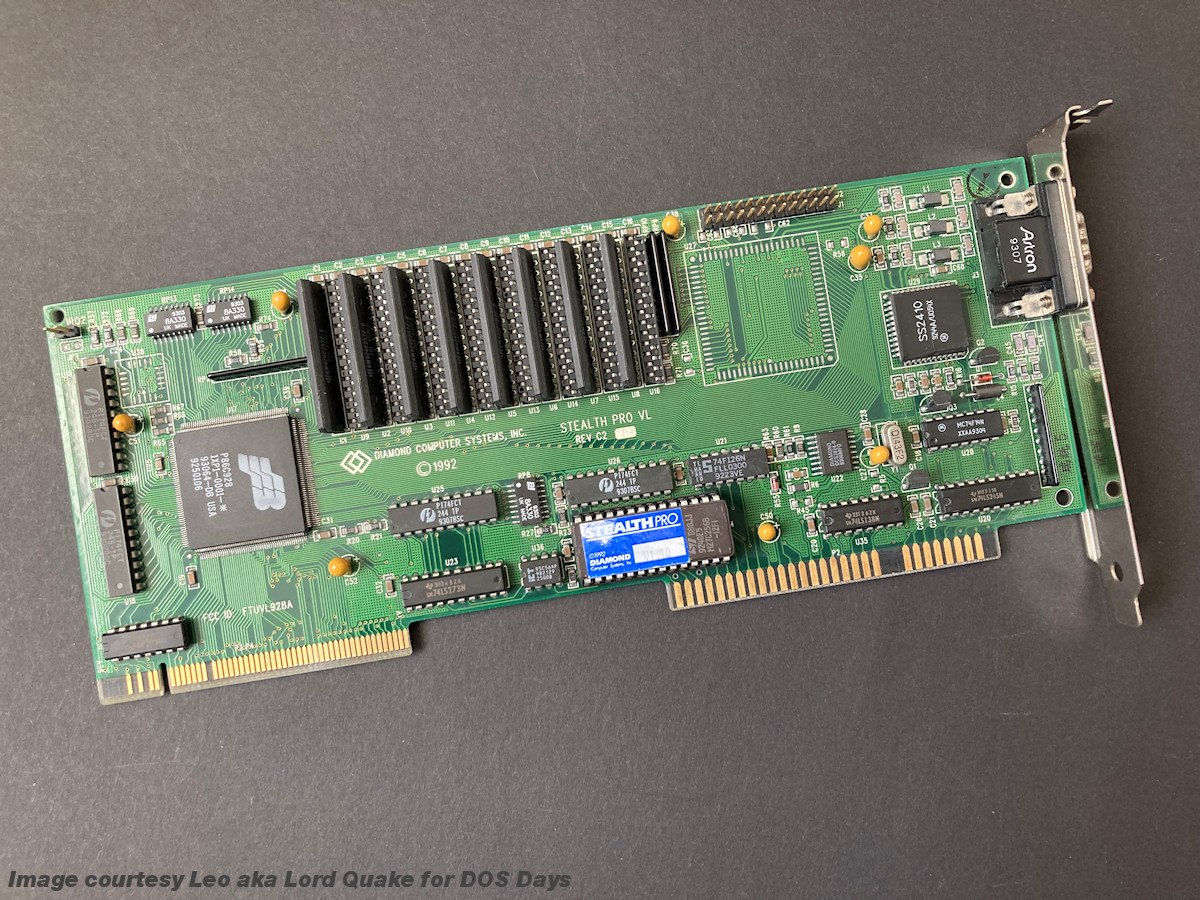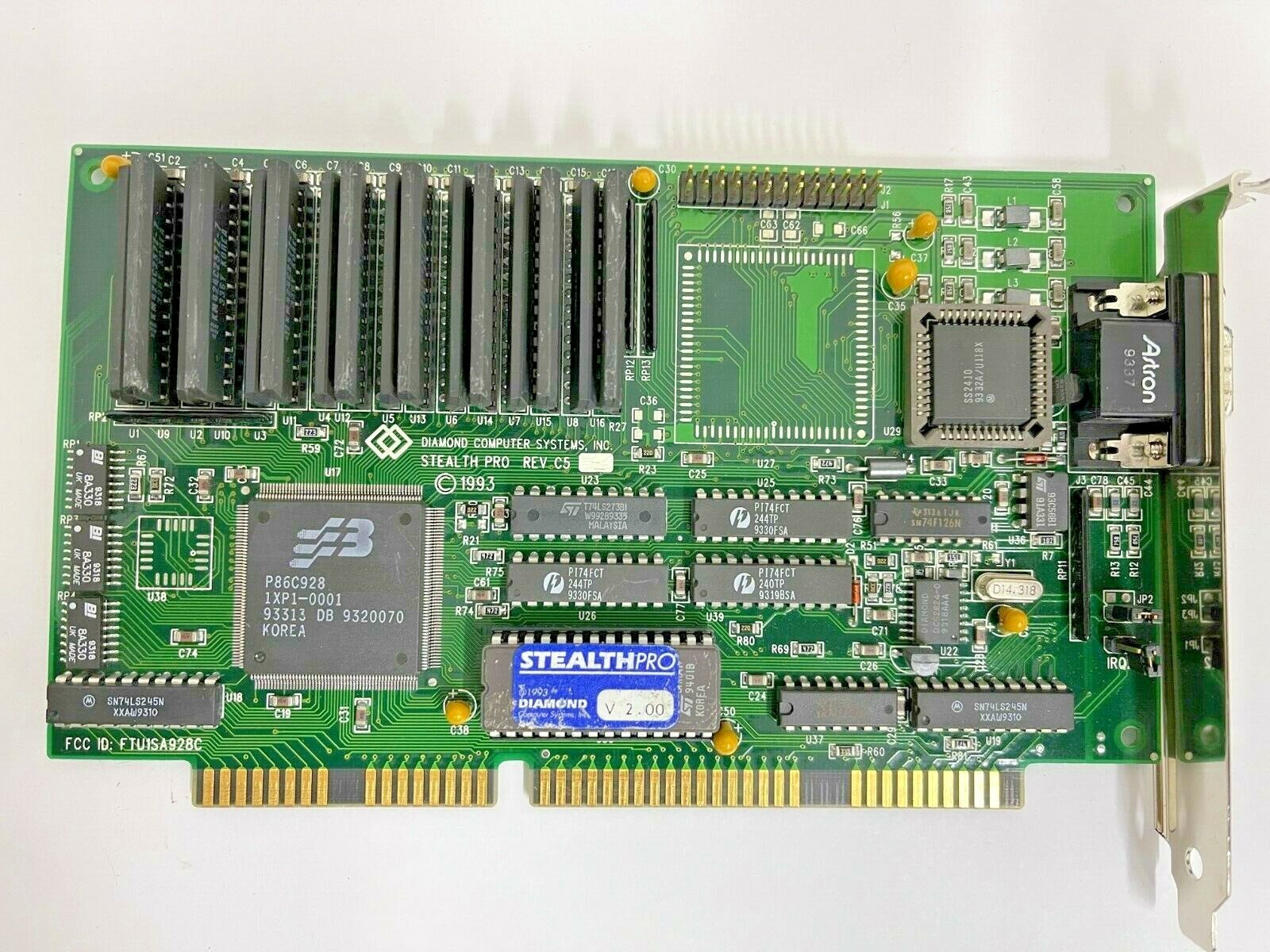Diamond Stealth Pro
The Stealth Pro was launched alongside the Stealth 24 in early 1993, and was their offering for anyone looking for a high-resolution 2D graphics accelerator for Windows. With its faster VRAM and ability to run at up to 1280 x 1024 resolution in 256 colours at a refresh rate of 72 Hz, or 800 x 600 in 16.7 million colours, the Stealth Pro was definitely their premium card at the time.
 |
Released | April 1993 |
| Bus | ISA 16-bit or VESA Local Bus | |
| Chipset | S3 86C928 | |
| Standards | Hercules, CGA, EGA, VGA, SVGA | |
| Memory | 1 MB or 2 MB VRAM | |
| Ports | 15-pin DSUB (video out) 26-pin VGA Feature connector |
|
| RAMDAC | Music Semiconductor MU9C1880 / SS2410 (24-bit) | |
| Part # | - | |
| FCC ID | FTU1SA928C (ISA cards) FTUVL928A (VLB cards) |
|
| Price | At launch: $349 (1 MB) +$150 for 2 MB RAM and RAMDAC upgrade | |
| See Also | Diamond Stealth 24 |
The RAMDAC used on the Stealth Pro is the 44-pin PLCC with Diamond part number SS2410. This supports 24-bit colour depths (6 bits wide for each of Red, Green and Blue), and was the same one used on some of the higher-end SpeedSTAR 24 and 24X cards. It is apparently pin-compatible with the Music Semiconductor MU9C1880.
While the 135 MHz S3 86C928 chipset supports up to 4 MB of VRAM, Diamond never offered the Stealth Pro as a 4 MB card, instead having the base card come with 1 MB with a $150 memory upgrade to 2 MB (which also got you an upgraded Brooktree 485 RAMDAC). This was most likely because they were looking to put the card into a specific price point that would be attractive to the more mainstream (mid-range) buyer. For those who wanted a 4 MB 86C928-based card, there were other pricier options such as the Metheus Premier 928-4M, though it retailed for a whopping $640.
The S3 86C928 supports hardware emulation of the Motorola 6845 CRT controller for backward-compatibility with MDA/Hercules, CGA and EGA standards.
Video resolutions supported by the card can be seen in this table:
| Resolution / Colour Depth | 1 MB | 2 MB |
|---|---|---|
| 640 x 480 x 8 | Yes | Yes |
| 640 x 480 x 16 | Yes | Yes |
| 640 x 480 x 24 | Yes | Yes |
| 640 x 480 x 32 | - | Yes |
| 800 x 600 x 4 | Yes | Yes |
| 800 x 600 x 8 | Yes | Yes |
| 800 x 600 x 16 | Yes | Yes |
| 800 x 600 x 32 | - | Yes |
| 1024 x 768 x 4 | Yes | Yes |
| 1024 x 768 x 8 | Yes | Yes |
| 1024 x 768 x 16 | - | Yes |
| 1024 x 768 x 24 | - | - |
| 1024 x 768 x 32 | - | - |
| 1280 x 1024 x 4 | Yes | Yes |
| 1280 x 1024 x 8 | - | Yes |
| 1280 x 1024 x 16 | - | - |
| 1600 x 1200 x 4 | - | Yes |
| 1600 x 1200 x 8 | - | Yes |
| 1152 x 968 x 4 | Yes | Yes |
Board Revisions
Several board revisions are known: C2, C3, C3.1, and C5.
In revisions C3 and C3.1, the IRQ jumper is in the top-left corner of the card. On revision C5 (ISA card) it's on the bottom-right.
I've only ever seen the earlier [C2/C3] revisions on VESA Local Bus variants, and revision C5
on an ISA variant.
I'm not totally sure what the large missing PLCC IC would have been used for. I suspect the design of the card catered for the ability to access 3 MB or 4 MB of VRAM in the future, so perhaps some kind of memory decoder, or used only on cards that used the EISA bus?
Competition
In 1993, the Diamond Stealth Pro competed directly with other high-end cards including the ATI Graphics Ultra Pro, Hercules Graphite, Number Nine GXE (which also used the S3 86C928A), and Orchid Fahrenheit VA.
In the Media
The Stealth Pro has a socket for an additional 1MB of VRAM ($150), which allows resolutions of up to 800-by-600 at 16.7 million colors, 1,024-by-768 at 65,536 colors, and 1,280-by-768 at 256 colors.
The Stealth Pro was the second-fastest card in both the Graphics Winmarks (12.6 megapixels per second) and the applications test suite (511.69), just ahead of the Orchid Fahrenheit VA. It turned in the fastest scores on the Excel portion of the applications suite at ranked third in the CorelDRAW and Superbase sections. It lagged only in running Ami Pro, but just 5 seconds behind the leader, ATI [Graphics Ultra Pro]."
PC Magazine, April 1993
All the boards we reviewed included 1MB of VRAM, except for the Metheus and Number Nine boards, which came with 4MB and 2MB, respectively; 2MB versions are available for all boards. Half of the products use 80-ns VRAM; the Metheus and Number Nine boards use faster 70-ns VRAM, and the Diamond board relies on 60-ns memory.
We found the high-refresh 24-bit Brooktree 485 RAMDAC on the #9GXE and Premier 928-4M; the 24-bit AT&T C491 sits on the Artist and Actix offerings. (S3 had not completed 24-bit drivers for the 86C928 that support the Brooktree 485 RAMDAC in time for our testing. Metheus makes its own 24-bit color drivers for the Premier; Number Nine Computer Corp. expects to have released 24-bit color drivers by the time you read this.)
The ELSA Winner 1000 uses a 24-bit Sierra 15025CV RAMDAC from Sierra Semiconductor. The Diamond Stealth Pro we saw uses Diamond Computer Systems' own 24-bit SS2410 RAMDAC; a $150 upgrade option includes another 1MB of VRAM for 1,280-by-1,024 at 256 colors and a Brooktree 485 RAMDAC. ELSA America, Diamond, and Number Nine each write their own Windows drivers. None of the products in this group came with OS/2 drivers because S3 had not made them available in time for our testing. Most of the vendors in this section expect to have OS/2 drivers by the time you read this.
The S3 86C928-based Diamond Stealth Pro garnered high test scores under Microsoft Windows, but it was not such a well-rounded DOS or AutoCAD performer. At $349, this sturdy, easy-to-install board is worth the consideration of Windows users."
PC Magazine, April 1993
Setting it Up
Jumper JP1 on the board allows you to opt to use IRQ 2/9. This is for the vertical retrace interrupt that was supported since EGA days, and allows the card to 'sync' with the start of a new screen refresh using a vertical retrace signal that is triggered on this interrupt line. If this jumper is on, IRQ2/9 is used for this. If it is off, the card will not use any interrupts, and therefore won't sync with the vertical retrace - this is rarely needed.
Jumpers JP2 and JP3 are factory set and should not be altered.
Downloads
Operation Manual Get in touch if you can provide this missing item! |
Original Utility Disk Comprises DOS utilities, CAD drivers and installer. |
Windows 3.1 Drivers Diamond Stealth Pro Windows 3.1 driver. |
Windows 3.1 Drivers Diamond Stealth Pro Windows 3.1 driver. |
AutoCAD Driver Diamond Stealth Pro AutoCAD driver. |
S3 UniVBE Utility S3's Universal VESA 2.0 driver. Supports 928 chipsets, but should work with later ones also |
Video BIOS
Get in touch if you can provide this missing item! |
Video BIOS
Get in touch if you can provide this missing item! |
Video BIOS
Get in touch if you can provide this missing item! |
Video BIOS
Get in touch if you can provide this missing item! |
More Pictures
.jpg)
.jpg)
.jpg)
.png)
All images above for this card (and the main pic at the top) were kindly provided by Leo aka Lord Quake.



